Exploring the Blue and Yellow Bedroom Aesthetic
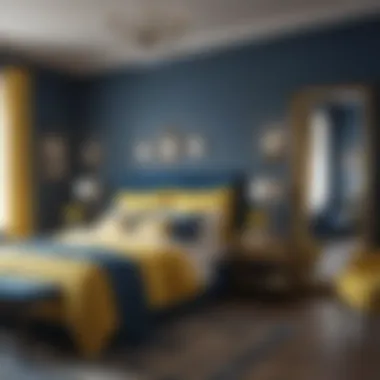

Intro
The interplay of colors can have a profound effect on our emotions and perceptions in a space. Particularly, the combination of blue and yellow speaks to harmonizing energies. With blue often associated with calmness and serenity, while yellow brings warmth and brightness, this duo creates a unique balance in bedroom design. This article aims to explore how these colors can transform a mundane bedroom into a vibrant yet tranquil retreat.
Current Trends
When it comes to contemporary bedroom design, the blue and yellow aesthetic has gained significant momentum. Trends vary widely, showcasing how this color scheme can be interpreted in numerous ways:
- Color Palettes: Variations of blue like navy or sky blue can be paired with shades of yellow from soft pastels to rich golds. The softer hues create a serene vibe, while bolder colors add a touch of drama.
- Popular Styles: In recent times, the Scandi style has thrived with this palette. Minimalist approaches often feature blue linens with sun-kissed yellow accents. Conversely, bohemian designs embrace vibrant prints combining the two colors for a more eclectic feel.
Visual Ideas
Visualizing the possibilities can inspire homeowners to take the plunge into this aesthetic. Below are some pertinent themes:
- Gallery of Styled Bedrooms: A curated collection showcasing bedrooms designed with blue walls and yellow decorative items, like cushions or artwork, highlight the versatility of this aesthetic. Some feature intricate patterns, while others lean towards solid color designs that invite tranquility.
- Before-and-After Transformations: Visual transformations provide compelling evidence of color's impact. A room simply painted in blue can look entirely different when yellow accents are added, shifting the mood from cold to inviting.
"Colors can communicate moods and feelings; blue and yellow together evoke a balance that can lift spirits while maintaining calm."
This exploration of the blue and yellow theme in bedroom design opens avenues for creativity and personal expression. The following sections will delve further into the psychological effects, practical applications, and ways to integrate various decor elements effectively.
Preface to Blue and Yellow
The combination of blue and yellow in bedroom design is more than just an aesthetic choice. This color pairing evokes feelings; it carries emotional weight and practical advantages. The appeal of blue often lies in its calming nature. It promotes relaxation and comfort, making it an ideal backdrop for a space dedicated to rest. Yellow, on the other hand, adds warmth and vibrancy. It can energize a space, infusing it with positivity and cheerfulness. Understanding the relationship between these colors is crucial for anyone looking to craft a serene yet stimulating bedroom environment.
By analyzing this duo, one learns the art of balancing tranquility with liveliness. The consideration goes beyond just blending colors; it also involves an exploration of color psychology, aesthetics, and historical contexts. This article aims to dissect specific elements regarding blue and yellow in bedroom decor, highlighting practical benefits while providing meticulous insights on design techniques.
Through thoughtful engagement with these themes, one can gain a broader appreciation of how these colors work together. The objective is to create spaces that not only look appealing but also feel welcoming. Special attention will be given to emotional reactions triggered by these colors and their long-term impact on the atmosphere of a bedroom.
Understanding the Color Psychology
Colors significantly influence emotions and behaviors. Blue is widely recognized for its soothing characteristics. It tends to lower blood pressure and heart rates in the realm of psychological effects. This is particularly important for bedrooms, as these spaces should ideally be conducive to restful sleep. A soft, cool blue can create serene environments that encourage relaxation. It promotes a quiet mind suitable for sleep.
Yellow, contrastingly, symbolizes energy and creativity. It is often associated with sunshine and joy. However, when used excessively, it may become overbearing. A moderate touch of yellow can uplift the mood without overwhelming the senses. Strategic placement of yellow accents can introduce brightness and cheerfulness to the otherwise calm blue ambiance.
Key points in color psychology include:
- Blue: Calming, promotes relaxation, suitable for sleep spaces.
- Yellow: Energetic, associated with happiness, can invigorate spaces.
- Balance is crucial in using these colors to maintain a harmonious bedroom atmosphere.
The Historical Significance of Blue and Yellow
Historically, colors carried deep meanings and played crucial roles in art, fashion, and interior design. Both blue and yellow have rich legacies that inform their current associations. Blue was often used in ancient cultures to signify divinity and trust. In many European artworks, blue pigments were sought after, often representing the heavens and spirituality. Conversely, yellow has roots in various cultures where it embodies warmth and light. In ancient Egypt, for instance, yellow was associated with gold and the divine.
Over time, these colors have evolved in significance yet remain linked to emotional and psychological implications. Their frequent use in various art movements helps to establish their value in design. The interplay between art and everyday life illustrates a continuity in the aesthetic appeal of blue and yellow through centuries.
Considerations in historical context include:
- Cultural Symbolism: Colors often reflect cultural values. Blue and yellow helped communicate ideas or emotions.
- Artistic Use: Historical artworks featuring these colors can inspire modern design choices.
By understanding these historical underpinnings, one can appreciate how blues and yellows might be utilized effectively to enhance personal spaces today.
The Basics of Color Combination
Understanding how to combine colors effectively is crucial when designing a bedroom. Color combination influences mood, aesthetics, and even the perception of space. Combinations like blue and yellow not only enhance visual appeal but also create an inviting atmosphere. When used thoughtfully, these colors can lead to a cohesive design that balances vibrance and tranquility.
Complementary vs. Analogous Colors
When discussing color combinations, it's essential to understand the difference between complementary and analogous colors.
- Complementary colors are opposites on the color wheel. For blue, its complementary color is orange. This pairing creates a dynamic contrast that can energize a space.
- In contrast, analogous colors are next to each other on the wheel. For blue, paired with green and yellow, these colors produce a harmonized flow.
For the bedroom, utilizing these color theories can be effective. A good balance ensures that spaces feel welcoming rather than overwhelming. For example, incorporating both blue and yellow in an analogous fashion while adding hints of gray can soften the room's energy.
"Choosing the right color combinations can transform the emotional impact of your space. Blue and yellow can bring out positive feelings while ensuring the space remains restful."
Choosing the Right Shades
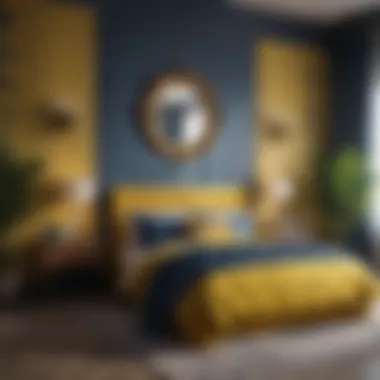
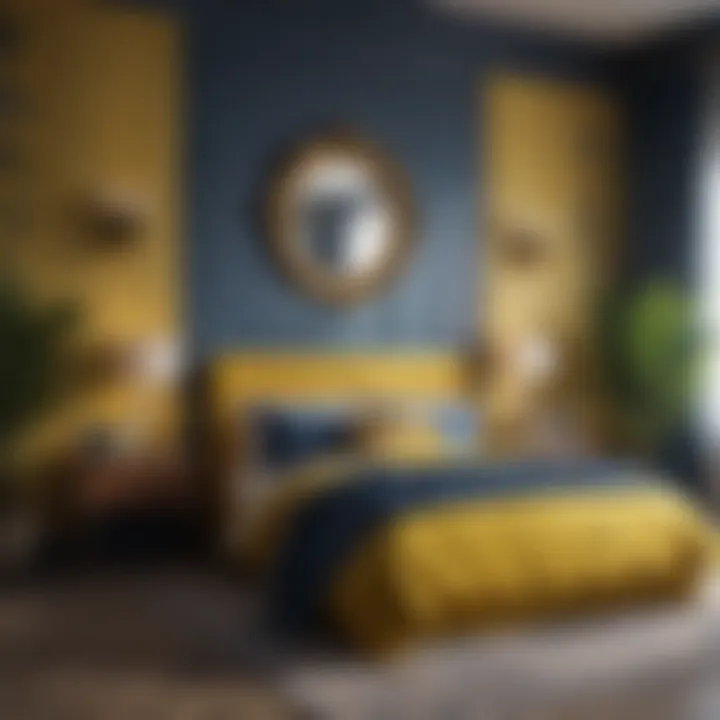
Once the basic understanding of color combinations is established, selecting the right shades becomes vital. Not all blues and yellows work well together. The key is to consider factors like lighting, room size, and existing decor.
- Start by identifying the room's natural light sources. A bright, sunny room can accommodate more vibrant shades, while a dimly lit space may benefit from softer hues.
- Consider the mood you want to create. Lighter shades of blue combined with pale yellow can evoke calmness. On the other hand, deeper hues, like navy blue paired with a mustard yellow, produce a cozier ambiance.
It's also wise to test paint samples in the actual space. Observe how these colors change throughout the day. Matching shades with fabrics and accessories can unify the design, creating a polished look.
Designing with Blue and Yellow
Designing with blue and yellow requires thoughtful planning and consideration. The combination of these two colors can create a dynamic yet tranquil environment. Blue evokes calmness and serenity, while yellow adds vibrance and energy. When used together, they can enhance the mood of a bedroom significantly. One must think carefully about how these colors interact with one another and with other design elements.
Incorporating Paint Colors
Choosing the right paint colors is crucial in establishing the foundational aesthetic of a bedroom. When deciding on shades of blue and yellow, consider the room's natural light. Lighter shades of blue can make a space feel more open, while deeper blues can create a cozier atmosphere. Choose yellows that complement the blues; soft buttery yellows blend well with pale blues but more vivid yellow hues can match deeper navy tones. Using a feature wall can anchor the color scheme, allowing you to choose one wall to highlight in yellow while keeping the rest in blue or vice versa.
A popular method is using a gradient effect, transitioning from blue at the bottom to yellow at the top, or vice versa. This not just highlights the colors but also introduces an interesting depth to the space.
Application of Textiles
Textiles play a vital role in enriching the blue and yellow aesthetic. From bed linens to cushions, the choice of fabric can elevate the overall design. Selecting textiles with patterns can help to tie together the color scheme. For instance, a blue and yellow geometric patterned duvet cover can serve as a statement piece.
Mixing various textures is important when choosing textiles. Soft fabrics like cotton for bed sheets paired with heavier textures such as velvet or wool for throw pillows can create a rich layered look. Area rugs in coordinating colors can ground the space, providing both comfort and a visual anchor. These elements should incorporate both colors to unify the overall design.
Using Wall Art and Accessories
Wall art and accessories provide an opportunity to infuse personality into the bedroom while reinforcing the blue and yellow theme. Look for art pieces that combine these colors naturally, whether it’s a bold abstract piece or soft watercolors. When selecting art, size matters. Large pieces can serve as focal points, while smaller artworks can create a gallery wall effect when arranged thoughtfully.
In addition, choose accessories such as lamps, vases, and pillows that incorporate both colors. Accessories can be more playful, allowing you to experiment with different shades and patterns. For instance, a vase in a vibrant yellow can pop against a blue backdrop, and cushions with blue accents on a yellow couch can tie the space together effectively.
"Combining blue and yellow not only brightens your bedroom but also invites warmth and tranquility."
Approaching the aesthetics of your bedroom with careful consideration of how blue and yellow interact will elevate your design choices. The integration of paint, textiles, wall art, and accessories can harmoniously create a space that is both inviting and visually appealing.
Pattern and Texture Utilization
Pattern and texture play a crucial role in the overall aesthetic of a blue and yellow bedroom. These elements not only add visual interest but also contribute to the spatial dynamics of the room. By strategically incorporating patterns and textures, one can enhance the depth and character of the space. It can help in balancing the vividness of blue and yellow hues, creating a more harmonious environment.
When designing a bedroom with blue and yellow, one must consider how patterns and textures interact with these colors. For instance, patterns can soften the starkness of yellow or add dimension to a muted blue. This creates a layered effect that can make a room feel warm and inviting. The balance of these elements can also prevent the design from appearing too chaotic or flat.
Exploring Geometric Patterns
Geometric patterns introduce an element of modernity and structure to the blue and yellow aesthetic. They can be found in various decor items, such as throw pillows, rugs, and wall art. The precision of geometric shapes complements the calmness of blue while the brightness of yellow can be tempered by these defined lines.
- Examples of Geometric Patterns:
- Stripes
- Chevrons
- Polka dots
- Hexagons
In practical application, a geometric-print rug might serve as the focal point in the room, drawing attention to the interplay of colors. Where to use these patterns also matters; perhaps a feature wall adorned with a geometric wallpaper can energize a corner or bring balance to a busy space.
Mixing Textures for Depth
Mixing different textures is essential for creating depth and intrigue in the blue and yellow bedroom aesthetic. Varied textures can transform an otherwise ordinary setup into an engaging and inviting room. Use soft fabrics, rough surfaces, and smooth finishes to create a tactile experience that invites exploration.
- Consider Using:
- Velvet cushions for softness
- Linen curtains for a natural touch
- Woven baskets for rustic charm
- Glossy furniture to reflect light
The interplay of these textures can also enhance the color scheme. For example, a soft yellow velvet throw on a cobalt blue bedspread can create a striking contrast that is visually appealing yet comforting.
In summary, understanding and utilizing patterns and textures are vital steps when designing with blue and yellow. These elements not only enhance the aesthetics but also contribute to the comfort and emotional resonance of the bedroom.
Lighting Considerations
Lighting plays a crucial role in any bedroom design, especially when utilizing a color palette like blue and yellow. The way light interacts with these colors can significantly affect the ambiance and mood of the space. In a blue and yellow bedroom, proper lighting can highlight the beauty of these hues, enhancing the overall aesthetic. It is essential to consider both natural and artificial lighting to create a balanced environment that fosters relaxation and creativity.
Natural Light and Its Effects
Natural light is an asset in decorating a blue and yellow bedroom. The sunlight filtering through windows can alter how these colors appear throughout the day. For example, during the morning, a soft, warm light can make yellow tones feel vibrant and cheerful, while blue can evoke calmness and tranquility. This dynamic interaction can create an uplifting environment.

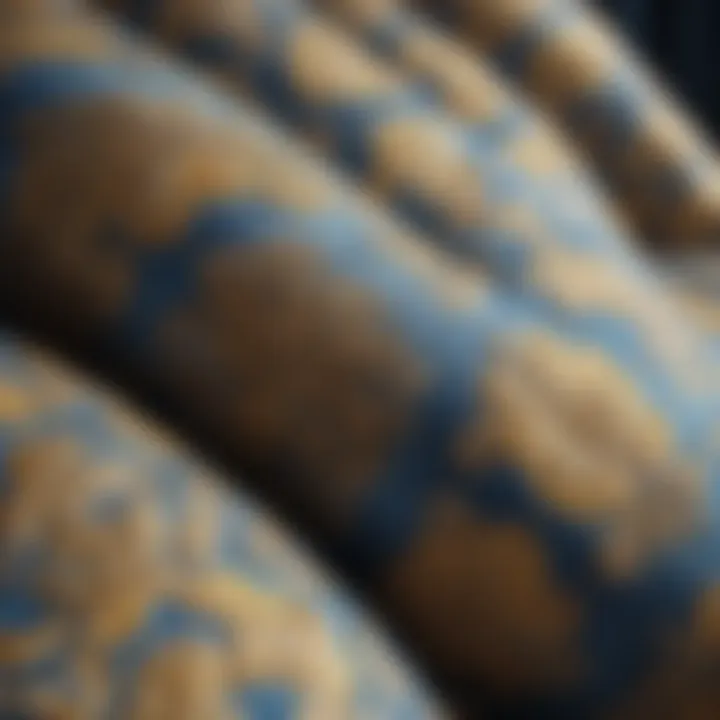
To maximize natural light, opting for larger windows or sheer curtains can help. These choices allow light to flow through while preventing harsh rays from overwhelming the space. Additionally, the placement of mirrors can reflect natural light, making the room feel larger and more inviting. Trimming tree branches outside the window can also ensure the light bathes the room without obstruction.
Natural light provides a changing palette that can enhance the emotional impact of a blue and yellow color scheme.
Artificial Lighting Options
While natural light is ideal, it cannot always be relied upon, especially in the evening or on cloudy days. Therefore, incorporating various artificial lighting options is essential. A layered approach helps in creating a flexible lighting plan that can adapt to different activities, such as reading or relaxing.
- Ambient Lighting: The primary source of light should be broad and soft, which can be achieved through ceiling lights or floor lamps. Fixtures with a warm glow can enhance the yellow while softening the blue.
- Task Lighting: Reading lamps or bedside lamps should be placed near areas where focused activities occur. Adjustable lamps can also allow for control over light intensity.
- Accent Lighting: This type of lighting can be used to highlight specific decor elements. For instance, wall sconces can frame a piece of art or a unique blue accent wall, drawing attention without overwhelming the space.
- Smart Lighting Options: Consider using smart bulbs that allow for color adjustability and dimming capabilities. This can add flexibility and allow the homeowner to switch between different moods easily.
Balancing these lighting elements will ensure that the blue and yellow tones complement each other, creating a harmonious atmosphere that resonates with personal style.
Furniture Selection
When designing a bedroom that features the dynamic blue and yellow aesthetic, the selection of furniture plays a critical role. The right pieces can elevate the overall look and feel of the space, contributing significantly to both functionality and style. Furniture selection involves not only choosing items that align with the color scheme but also considering how these pieces harmonize with the existing decor.
Choosing the Right Pieces
The process of choosing the right furniture begins with understanding the overall theme and intention of the room. For a bedroom that boasts blue and yellow tones, consider items that complement or contrast the colors effectively.
- Beds: A neutral headboard can serve as an anchor within the bold color scheme. Consider upholstered beds in light gray or beige that allow blue and yellow accents to stand out.
- Dressers and Nightstands: Opt for wooden materials that can bring warmth to the space. A yellow-painted dresser can create a focal point, while a blue nightstand can subtly tie everything together.
- Seating Options: If space allows, a small reading chair in a light blue fabric can provide comfort and style.
This selection ensures that furniture choices not only serve practical purposes but also enhance the aesthetic appeal.
Balancing Size and Space
In a bedroom, size and space are frequently overlooked elements during the design process. Balancing these factors is essential to avoid a cluttered look or overly sparse arrangements.
- Assessing Room Dimensions: Begin by measuring the room. Knowing the dimensions helps in selecting appropriately sized furniture that fits well without overwhelming the space.
- Creating Functionality: Think about the functions each piece will serve. For instance, if the goal is to create a cozy reading nook, ensure the seating is not too large to compromise walking space.
- Visual Weight: Consider the visual weight of each piece. Lighter colors or transparent materials can make a room feel larger and more airy, which can be particularly beneficial in smaller bedrooms.
- Flow of Movement: Ensure that there is enough space for movement. It is advisable to have at least two to three feet of walking space in pathways, especially around the bed and desk areas.
By carefully considering size and layout, one can achieve a balanced approach that enhances the blue and yellow aesthetic while maintaining function and comfort.
Accessorizing for Style
Accessorizing in bedroom design plays a vital role in creating a cohesive and inviting atmosphere. When working with the blue and yellow color scheme, accessories can enhance the overall aesthetic. They serve as a bridge between colors, textures, and patterns, tying the entire room together. Thoughtful accessorizing can elevate the space from mundane to memorable. This approach allows homeowners to express their personality while ensuring that the decor remains stylish and functional.
One of the significant benefits of accessorizing is the flexibility it offers. With the right items, you can easily update the room without committing to a complete redesign. Accessories can also aid in making personal connections to the space, creating a sense of comfort and belonging. When utilizing blue and yellow, careful selection of accessories will help maintain balance and harmony, resulting in a pleasing visual experience.
Rugs and Carpets
Rugs and carpets are more than just functional elements that provide warmth underfoot. They are essential accessories that can define spaces within a room. When considering rugs in a blue and yellow bedroom, it is crucial to think about the patterns and colors selected. A simple, solid blue rug can ground the room, while a yellow patterned one can add a lively touch.
When selecting a rug, consider the size and placement in the room. A large area rug can help unify different elements in the space, bringing together your chosen color palette. It can also dictate the arrangement of furniture, making the layout more inviting for relaxation or conversation.
In addition to complimenting the color scheme, rugs introduce texture. A plush, textured carpet can create a cozy vibe, while a flat weave can lend a more modern feel. Consider how the feel of the rug interacts with the surrounding decor; this interaction is vital for cohesiveness.
Curtains and Drapes
Curtains and drapes significantly affect the mood and style of a bedroom. They are not merely functional; they are a primary accessory that can soften the space. When choosing fabrics for window treatments, shades of blue or yellow can enhance the color scheme while allowing natural light to filter in appropriately.
Opt for fabrics that offer various textures. Sheer curtains allow light to enter while providing privacy, softening the harshness of direct sunlight. Conversely, heavier drapes can create a dramatic effect; they provide warmth and intimacy, transforming the atmosphere entirely.
The length and fullness of curtains can also influence the perception of space within the room. Installing longer drapes that reach the floor creates an illusion of higher ceilings, which is beneficial for smaller bedrooms.
Incorporate patterns that relate to the rest of the decor. For instance, if you have geometric patterns in your rugs, consider patterned curtains with a similar motif. This approach fosters unity in the design.
"The right accessories not only accentuate elements of design but also act as a reflection of personal taste."
In summary, careful accessorizing with rugs and curtains allows homeowners to enhance the blue and yellow aesthetic. These elements contribute both visually and functionally, enabling a harmonious and inviting bedroom environment. The choices made here have the potential to transform a simple space into a personalized haven.
Personal Touches and Customization
Incorporating personal touches into a blue and yellow bedroom is crucial for creating a space that feels uniquely yours. This aesthetic can sometimes seem rigid or predefined, yet adding personal elements allows for flexibility and individuality. Personal touches help transform the room into a sanctuary for relaxation, creativity, and comfort. It also expresses your personality, making the environment inviting and warm.
When customizing these spaces, consider specific elements that hold meaning to you. This includes family photos, sentimental artwork, or souvenirs from travels. These pieces can integrate seamlessly into the blue and yellow color scheme, enhancing the overall feel of the room while still maintaining a cohesive look.
Customization not only brings beauty but also deeper emotional connections to the space. It reminds us of moments, people, and places we treasure. You should think about how you want these personal touches to blend with the existing décor.
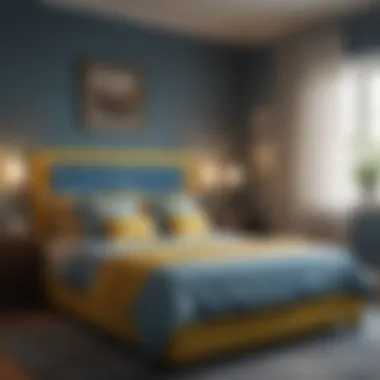
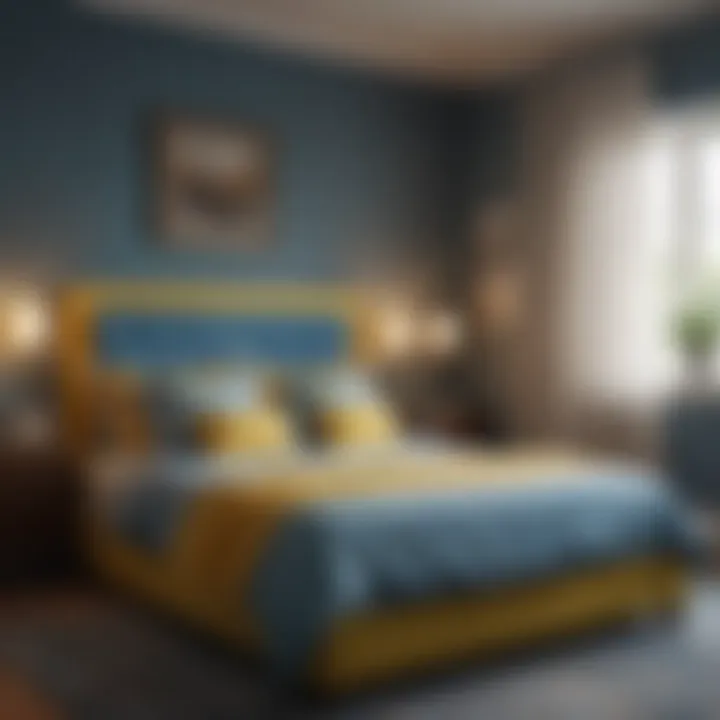
Incorporating Personal Artworks
Personal artworks can significantly define a bedroom's interior. When choosing pieces, focus on ones that resonate with you. An original painting in shades of blue or yellow can accentuate the color palette while reflecting your taste.
Consider the following tips for incorporating art:
- Mix and Match: Combine different styles, like modern art with vintage frames.
- Gallery Wall: Create a gallery wall with a curated selection of your favorite pieces.
- Placement Matters: Hang artworks at eye level to invite appreciation without overwhelming the space.
Carefully selected artworks can become conversation starters, adding dynamic energy to the space, contributing to the personality of the overall design.
Displaying Personal Collections
Displaying personal collections offers another opportunity to infuse individuality into your bedroom. Whether it is books, trinkets, or ceramics, these items can reflect your hobbies and interests.
A few considerations when displaying collections include:
- Showcase Uniqueness: Objects that are not commonly found can stand out. Consider showcasing unique items that highlight your experiences.
- Use Display Cases: Glass cabinets or open shelves can elegantly present your collections while protecting them.
- Curate Wisely: Display only items that resonate with your aesthetic vision; too many items can create clutter.
Displaying personal collections within the context of blue and yellow decor can foster a vibrant yet harmonious atmosphere. This integration of personal flair can create a space that feels both inviting and expressive.
Common Mistakes to Avoid
When creating a bedroom space that employs the blue and yellow aesthetic, several common mistakes can work against the desired outcome. Understanding these pitfalls is crucial for any homeowner or designer aiming for a balanced and inviting environment. The blue and yellow combination offers vibrant energy and serenity, but improper applications can lead to visual chaos or overwhelming sensations. Such oversights may distract from the room’s primary function as a restful sanctuary.
Too Much Contrast
One of the most frequent errors in design is relying too heavily on contrasting shades of blue and yellow. While contrast can add dynamism to a space, excessive use can result in a jarring visual experience. This may create an environment that feels stark or uncomfortable rather than warm and inviting.
For instance, pairing a bright yellow with a deep navy blue might seem appealing, but without moderation, it can overwhelm the senses. Instead, consider using various shades that complement instead of compete. For example, softer hues like pastel yellow can harmonize beautifully with lighter shades of blue, creating a peaceful atmosphere. Focus on integrating similar saturation levels to foster a more cohesive look.
"Effective color combinations rely on more than just pairing opposites; they demand a careful balance of tone and saturation."
Some strategies to avoid too much contrast include:
- Use gradients. Gradual transitions between colors can smooth the visual experience.
- Incorporate neutrals. White, gray, or beige can serve as a buffer, allowing colors to breathe.
- Limit accent colors. Rather than saturating the room with both blue and yellow, focus on one as a primary and use the other as an accent in selected areas.
Ignoring Balance and Harmony
Another significant mistake is disregarding the principles of balance and harmony. In design, balance can often be achieved through careful placement of furniture, accessories, and color distribution. Ignoring these elements may lead to a look that feels chaotic or disorganized.
Achieving harmony in a blue and yellow bedroom means ensuring that the colors work together in a way that is visually appealing. For example, a heavy application of blue in one area contrasted with only a small amount of yellow in another can create an unbalanced look.
To ensure balance, consider the following tips:
- Visual weight. Distribute elements evenly throughout the room. For example, if one side is dominated by a large blue armchair, balance it with yellow cushions on a sofa.
- Repeat colors. Use both blue and yellow in various items around the room. This could be through artwork, pillowcases, or throws that feature both colors.
- Layer thoughtfully. Create layers through textiles or decor that incorporate both tones in a balanced manner.
Overall, mindful application of color theory can mitigate these mistakes and result in a beautifully designed space that encourages relaxation. Combining blue and yellow should enhance comfort, providing a sanctuary rather than a chaotic space.
Final Thoughts on Blue and Yellow Bedrooms
The exploration of blue and yellow as a bedroom aesthetic yields significant insights into both color theory and personal design philosophy. These colors possess unique attributes that can transform a simple space into a meaningful retreat. Blue often evokes feelings of calm and tranquility, while yellow radiates warmth and energy. The combination of these two can foster an environment that is both soothing and uplifting, ideal for relaxation and rejuvenation.
Highlighting the Versatility
One of the key benefits of using blue and yellow in bedroom design is their versatility.
Blue and yellow come in numerous shades, each creating differing atmospheres depending on their application. For instance, a soft pastel blue paired with buttery yellow can produce a serene, airy feel. Conversely, deeper shades like navy and mustard can create a more dramatic and sophisticated ambiance.
When integrating these colors, consider the following:
- Color Proportions: Use blue predominantly with accents of yellow to create visual stability, or vice versa for a lively contrast.
- Layering: Add various textiles such as cushions, rugs, or bedspreads in these colors to accentuate their impact without overwhelming the space.
- Patterns: Incorporate patterned elements like wallpaper or throw pillows that blend these tones to add depth.
By adjusting the balance and combinations of blue and yellow, one can adapt the aesthetic to suit changing tastes and needs, showcasing the inherent flexibility of this palette.
Encouraging Personal Expression
Another crucial aspect of designing with blue and yellow is the opportunity for personal expression. A bedroom is an intimate space, and incorporating one’s preferences can immensely enhance its atmosphere.
By recognizing the colors as tools for expression, individuals can personalize their spaces in meaningful ways. This customization could manifest in various forms:
- Art and Décor: Hanging art pieces that feature blue and yellow can not only tie the room together but also reflect personal tastes and interests.
- Personal Collections: Displaying collections, whether they be books, travel souvenirs, or crafts, in hues that resonate with blue and yellow can tell a story about the homeowner.
- Characteristic Furniture Choices: Selecting furniture in these colors thoughtfully can further emphasize the desired aesthetic while acknowledging functional needs.
"Color is the keyboard, the eye is the harmon, the soul is the piano with many strings." - Wassily Kandinsky
By thoughtfully applying these principles, house owners and housewives can create a space that not only functions well but also speaks to their unique sensibilities.



